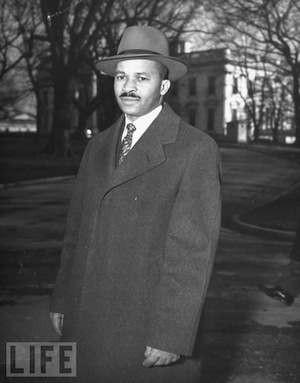
On Feb. 8, 1944, Harry S. McAlpin made history when he became the first African American journalist admitted to a White House press conference. The break through came just days after 13 African American publishers met with President Franklin Delano Roosevelt and presented him with 21 goals for a post-war America. These goals included:
- Abolition of the color bar in industry;
- Equal opportunity for employment;
- Equality in all public educational facilities;
- Unrestricted suffrage in national, state and municipal elections, including primaries;
- Full government protection of all civil rights and liberties;
- Government refusal to impose, enforce or sanction patterns of racial segregation;
- Full protection and equality of treatment and opportunity for [Black] members of the U. S. Armed Forces;
- Extension of the Social Security plan;
- Application of the Atlantic Charter to all colonial and other exploited peoples.
Black newspapers had long championed freedom and equality, fighting racial oppression, segregation, lynchings and slavery throughout the nation’s history.
Even though he was admitted to the press conference, McAlpin and other Black reporters still faced racism by press committees that controlled credentials for Congress and the White House.
Time Magazine reported in 1944:
“For the first time, a Negro newsman was admitted last week to the President’s regular press conference, granted credentials … [to] Harry McAlpin of the Atlanta Daily World (circ. 23,000) and the Negro Newspaper Publishers’ Association.
“Reporter McAlpin went into the conference without having been accepted by the Congressional Galleries’ standing committee or by the White House Correspondents’ Association, which ordinarily pass upon an applicant before credentials are issued. No Negro has ever received their approval.
“Virginia-born Presidential Secretary Stephen T. Early took responsibility for McAlpin’s admission, said his status as correspondent had satisfied White House requirements. At week’s end the bypassed Galleries’ committee and the Correspondents’ Association had said nothing, done nothing.”
McAlpin covered both Presidents Roosevelt and Harry Truman for 51 black newspapers. He was also a Navy war correspondent and spokesman for the Department of Agriculture.
McAlpin was among the founders of The Capital Press Club, because in the 1940s the White House Correspondents’ Association and the National Press Club practiced racial segregation, barring African American journalists from membership.
Later McAlpin practiced law in Louisville, Ky. In 1960, McAlpin became defense counsel for 12 student leaders of lunch-counter sit-ins. A complaint was filed after he and Black journalists were refused admittance to a hearing for the students, who had been expelled from Kentucky State College for their civil rights actions.
In 1948, Alice Dunningham became the first Black female White House correspondent.
Photo: Harry McAlpin makes history – and Life Magazine’s cover – as the first African American reporter to attend a White House news conference on Feb. 8, 1944. (via Blue Lines Blog)










